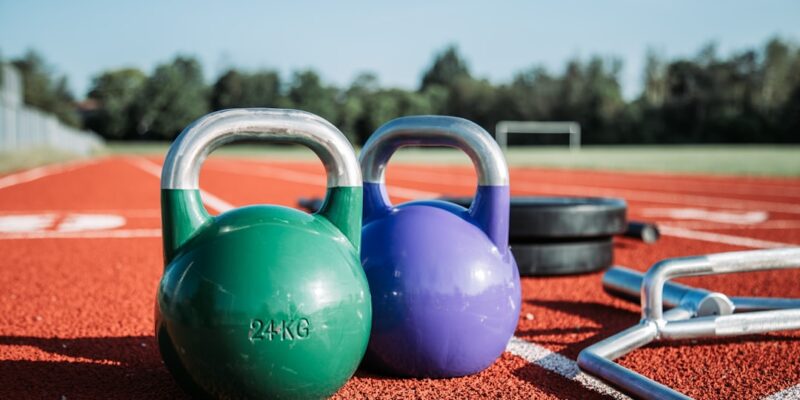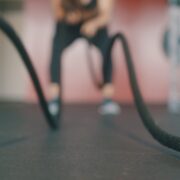
Build Strength and Power with Kettlebell Workouts
Kettlebell workouts have gained popularity in recent years for their ability to build strength and power. These workouts involve using a kettlebell, a cast-iron or steel weight with a handle, to perform various exercises that target different muscle groups. Kettlebell training is effective because it engages multiple muscle groups at once, leading to increased muscle activation and recruitment. In addition, the unique shape and design of the kettlebell allows for dynamic movements that challenge stability and coordination. Whether you are a beginner or an experienced athlete, incorporating kettlebell workouts into your fitness routine can help you achieve your strength and power goals.
Key Takeaways
- Kettlebell workouts are effective for building strength and power.
- Benefits of kettlebell training include improved grip strength, core stability, and overall muscular endurance.
- Choosing the right kettlebell weight is important for avoiding injury and maximizing results.
- Essential kettlebell exercises for building strength and power include swings, cleans, snatches, and presses.
- Proper technique and form are crucial for safe and effective kettlebell workouts.
Benefits of Kettlebell Training for Building Strength
One of the main benefits of kettlebell training is increased muscle activation and recruitment. Unlike traditional weightlifting exercises that isolate specific muscles, kettlebell exercises require the use of multiple muscle groups simultaneously. This leads to greater overall muscle activation and recruitment, resulting in improved strength gains. For example, a kettlebell swing engages the muscles in the hips, glutes, hamstrings, and core, providing a full-body workout.
Another benefit of kettlebell training is improved grip strength. The handle of the kettlebell is thicker than a dumbbell or barbell, which requires more grip strength to hold onto during exercises. This increased demand on the grip muscles can lead to improved grip strength over time. A strong grip is not only important for lifting heavier weights but also for everyday activities such as carrying groceries or opening jars.
Kettlebell training also enhances core stability. Many kettlebell exercises require the use of the core muscles to stabilize the body during dynamic movements. For example, a Turkish get-up involves lying on the ground and then standing up while holding a kettlebell overhead. This exercise challenges the core muscles to maintain stability throughout the movement, leading to improved core strength and stability.
Finally, kettlebell training can increase power output. Power is the ability to generate force quickly, and kettlebell exercises often involve explosive movements that require power. For example, a kettlebell snatch involves swinging the kettlebell from between the legs to overhead in one fluid motion. This exercise requires a combination of strength and speed, resulting in increased power output.
How to Choose the Right Kettlebell Weight for Your Fitness Level
When selecting a kettlebell weight, there are several factors to consider. First, you should consider your current fitness level and strength. If you are new to kettlebell training or have limited strength, it is recommended to start with a lighter weight to focus on proper form and technique. As you become more comfortable and stronger, you can gradually increase the weight.
Another factor to consider is the specific exercise you will be performing. Some exercises, such as swings or snatches, require more power and strength than others. For these exercises, you may need a heavier kettlebell weight. On the other hand, exercises that focus on isolation or stability, such as Turkish get-ups or single-arm presses, may require a lighter weight.
It is also important to listen to your body and avoid using a weight that is too heavy for you. Using a weight that is too heavy can lead to poor form and increased risk of injury. It is better to start with a lighter weight and gradually increase as you become stronger and more comfortable with the movements.
Essential Kettlebell Exercises for Building Strength and Power
| Exercise | Description | Muscles Worked | Repetitions | Sets |
|---|---|---|---|---|
| Swing | A ballistic exercise that involves swinging the kettlebell between the legs and up to shoulder height. | Glutes, hamstrings, quads, core, shoulders, and back. | 10-20 | 3-5 |
| Clean and Press | A combination exercise that involves cleaning the kettlebell to the rack position and then pressing it overhead. | Shoulders, triceps, core, glutes, and hamstrings. | 6-8 | 3-5 |
| Snatch | A ballistic exercise that involves swinging the kettlebell between the legs and up to overhead in one fluid motion. | Shoulders, back, core, glutes, and hamstrings. | 8-10 | 3-5 |
| Turkish Get-Up | A complex exercise that involves lying on the ground and standing up while holding the kettlebell overhead. | Shoulders, triceps, core, glutes, and hamstrings. | 1-2 per side | 3-5 |
| Goblet Squat | A squat variation that involves holding the kettlebell in front of the chest. | Quads, glutes, hamstrings, and core. | 10-12 | 3-5 |
There are several key kettlebell exercises that are effective for building strength and power. These exercises target different muscle groups and can be modified to suit different fitness levels. Here are some essential kettlebell exercises:
1. Kettlebell Swing: The kettlebell swing is a foundational exercise that targets the hips, glutes, hamstrings, and core. To perform a swing, stand with your feet shoulder-width apart and hold the kettlebell with both hands between your legs. Hinge at the hips and swing the kettlebell forward, using the momentum to bring it up to chest height. Repeat for the desired number of repetitions.
2. Kettlebell Goblet Squat: The goblet squat is a lower body exercise that targets the quads, glutes, and core. Hold the kettlebell by the horns (the sides of the handle) with both hands at chest height. Squat down, keeping your chest up and your knees in line with your toes. Push through your heels to stand back up. Repeat for the desired number of repetitions.
3. Kettlebell Clean and Press: The clean and press is a compound exercise that targets the shoulders, back, and arms. Start with the kettlebell on the ground in front of you. Hinge at the hips and grab the kettlebell with one hand, swinging it up to shoulder height. From there, press it overhead, fully extending your arm. Lower the kettlebell back down to shoulder height and repeat for the desired number of repetitions.
4. Kettlebell Turkish Get-Up: The Turkish get-up is a full-body exercise that targets the core, shoulders, and hips. Start by lying on your back with one arm extended overhead, holding onto the kettlebell. Roll onto your side and use your free hand to prop yourself up onto your elbow. From there, push up onto your hand and then onto your knee, keeping your eyes on the kettlebell at all times. Stand up while keeping the kettlebell overhead, then reverse the movement to return to the starting position.
Tips for Proper Kettlebell Technique and Form
Proper technique and form are crucial when performing kettlebell exercises to prevent injury and maximize results. Here are some tips for maintaining proper technique and form:
1. Engage your core: Throughout each exercise, focus on engaging your core muscles to maintain stability and control. This will help protect your lower back and improve overall strength.
2. Keep your shoulders down and back: Avoid shrugging your shoulders or hunching forward during kettlebell exercises. Instead, keep your shoulders down and back to maintain proper alignment and prevent strain on the neck and upper back.
3. Use a controlled and fluid motion: Kettlebell exercises should be performed with a controlled and fluid motion. Avoid using jerky or fast movements, as this can increase the risk of injury. Instead, focus on maintaining control throughout each exercise.
4. Breathe properly: Proper breathing is important during kettlebell exercises to provide oxygen to the muscles and maintain stability. Inhale during the eccentric phase (lowering or lengthening of the muscle) and exhale during the concentric phase (contracting or shortening of the muscle).
5. Start with lighter weights: If you are new to kettlebell training or trying a new exercise, start with a lighter weight to focus on proper form and technique. As you become more comfortable and stronger, you can gradually increase the weight.
Kettlebell Workouts for Upper Body Strength and Power
Kettlebell workouts can be tailored to target specific muscle groups, including the upper body. Here are some sample kettlebell workouts for building upper body strength and power:
1. Upper Body Superset Workout:
– Kettlebell Clean and Press: 3 sets of 8-10 reps per arm
– Kettlebell Bent Over Row: 3 sets of 8-10 reps per arm
– Rest for 60 seconds between sets
2. Upper Body Circuit Workout:
– Kettlebell Push Press: 3 sets of 10-12 reps per arm
– Kettlebell Renegade Row: 3 sets of 10-12 reps per arm
– Kettlebell Bicep Curl: 3 sets of 10-12 reps per arm
– Rest for 30 seconds between exercises and 60 seconds between sets
3. Upper Body Tabata Workout:
– Kettlebell Snatch: 20 seconds of work, 10 seconds of rest, for 8 rounds per arm
– Kettlebell Push-Up: 20 seconds of work, 10 seconds of rest, for 8 rounds
– Rest for 60 seconds between exercises
Kettlebell Workouts for Lower Body Strength and Power
Kettlebell workouts are also effective for building lower body strength and power. Here are some sample kettlebell workouts for targeting the lower body:
1. Lower Body Superset Workout:
– Kettlebell Goblet Squat: 3 sets of 10-12 reps
– Kettlebell Romanian Deadlift: 3 sets of 10-12 reps
– Rest for 60 seconds between sets
2. Lower Body Circuit Workout:
– Kettlebell Swing: 3 sets of 15-20 reps
– Kettlebell Reverse Lunge: 3 sets of 10-12 reps per leg
– Kettlebell Sumo Deadlift: 3 sets of 10-12 reps
– Rest for 30 seconds between exercises and 60 seconds between sets
3. Lower Body Tabata Workout:
– Kettlebell Squat Jump: 20 seconds of work, 10 seconds of rest, for 8 rounds
– Kettlebell Single-Leg Deadlift: 20 seconds of work, 10 seconds of rest, for 8 rounds per leg
– Rest for 60 seconds between exercises
Combining Kettlebell Workouts with Cardio for Maximum Results
Combining kettlebell workouts with cardio exercises can help maximize results and improve overall fitness. Cardio exercises such as running, cycling, or jumping rope can increase heart rate and burn calories, while kettlebell exercises build strength and power. Here are some sample workouts that incorporate both kettlebell exercises and cardio:
1. Kettlebell Circuit with Cardio Intervals:
– Kettlebell Swing: 3 sets of 15-20 reps
– Jumping Jacks: 1 minute
– Kettlebell Clean and Press: 3 sets of 8-10 reps per arm
– High Knees: 1 minute
– Kettlebell Goblet Squat: 3 sets of 10-12 reps
– Mountain Climbers: 1 minute
– Rest for 30 seconds between exercises and 60 seconds between sets
2. Kettlebell Tabata with Cardio Intervals:
– Kettlebell Snatch: 20 seconds of work, 10 seconds of rest, for 8 rounds per arm
– Burpees: 1 minute
– Kettlebell Push Press: 20 seconds of work, 10 seconds of rest, for 8 rounds per arm
– Jump Rope: 1 minute
– Rest for 60 seconds between exercises
3. Kettlebell HIIT with Cardio Intervals:
– Kettlebell Swing: 30 seconds of work, 30 seconds of rest, for 5 rounds
– Sprinting: 30 seconds
– Kettlebell Clean and Press: 30 seconds of work, 30 seconds of rest, for 5 rounds per arm
– Jumping Lunges: 30 seconds
– Rest for 60 seconds between exercises
Kettlebell Workouts for Athletes and Sports Performance
Kettlebell training can benefit athletes and improve sports performance by enhancing strength, power, and overall fitness. Here are some sample workouts for athletes in various sports:
1. Soccer Workout:
– Kettlebell Single-Leg Deadlift: 3 sets of 10-12 reps per leg
– Kettlebell Swing: 3 sets of 15-20 reps
– Kettlebell Clean and Press: 3 sets of 8-10 reps per arm
– Rest for 60 seconds between sets
2. Basketball Workout:
– Kettlebell Goblet Squat: 3 sets of 10-12 reps
– Kettlebell Snatch: 3 sets of 8-10 reps per arm
– Kettlebell Renegade Row: 3 sets of 10-12 reps per arm
– Rest for 60 seconds between sets
3. Tennis Workout:
– Kettlebell Swing: 3 sets of 15-20 reps
– Kettlebell Push Press: 3 sets of 8-10 reps per arm
– Kettlebell Turkish Get-Up: 3 sets of 5 reps per side
– Rest for 60 seconds between sets
Incorporating Kettlebell Workouts into Your Fitness Routine for Long-Term Strength and Power Gains
To incorporate kettlebell workouts into your fitness routine for long-term strength and power gains, it is important to have a plan and be consistent. Here are some tips for incorporating kettlebell workouts into your routine:
1. Set specific goals: Determine what you want to achieve with your kettlebell training, whether it’s building strength, increasing power, or improving overall fitness. Set specific goals and track your progress to stay motivated.
2. Schedule regular workouts: Set aside dedicated time in your schedule for kettlebell workouts. Aim for at least two to three sessions per week to see results.
3. Start with proper form and technique: Before increasing the weight or intensity, focus on mastering proper form and technique. This will help prevent injury and ensure that you are getting the most out of each exercise.
4. Gradually increase weight and intensity: As you become stronger and more comfortable with the movements, gradually increase the weight or intensity of your kettlebell workouts. This will help continue to challenge your muscles and promote strength and power gains.
5. Mix up your workouts: To prevent boredom and continue making progress, mix up your kettlebell workouts by incorporating different exercises, rep ranges, and rest periods. This will keep your body guessing and prevent plateaus.
In conclusion, kettlebell training is an effective way to build strength and power. The unique design of the kettlebell allows for dynamic movements that engage multiple muscle groups at once, leading to increased muscle activation and recruitment. Kettlebell training can improve grip strength, enhance core stability, and increase power output. By choosing the right kettlebell weight for your fitness level, focusing on proper technique and form, and incorporating kettlebell workouts into your fitness routine, you can achieve long-term strength and power gains. So why not give it a try and see the benefits for yourself?
FAQs
What are kettlebell workouts?
Kettlebell workouts are exercises that involve the use of a kettlebell, which is a cast-iron or steel weight with a handle. These workouts typically involve swinging, lifting, and pressing the kettlebell in various ways to build strength and power.
What are the benefits of kettlebell workouts?
Kettlebell workouts can help improve strength, power, endurance, and overall fitness. They can also help improve balance, coordination, and flexibility. Additionally, kettlebell workouts can be a great way to burn calories and lose weight.
What muscles do kettlebell workouts target?
Kettlebell workouts can target a variety of muscles, including the legs, glutes, core, back, shoulders, and arms. Depending on the specific exercise, different muscles may be targeted more or less.
Are kettlebell workouts safe?
Kettlebell workouts can be safe when performed correctly and with proper form. However, it is important to start with lighter weights and gradually increase the weight as strength and technique improve. It is also important to warm up properly before starting a kettlebell workout and to listen to your body and rest if you experience pain or discomfort.
Can kettlebell workouts be done at home?
Yes, kettlebell workouts can be done at home with a kettlebell and some space to move around. However, it is important to have proper instruction and guidance to ensure proper form and technique. It may be helpful to work with a certified kettlebell instructor or watch instructional videos to learn proper technique.



















Hey there! Do you know if they make any plugins to help
with Search Engine Optimization? I’m trying to get my website to rank for some targeted keywords but I’m not seeing very good
gains. If you know of any please share. Kudos! I saw similar
blog here: Eco bij